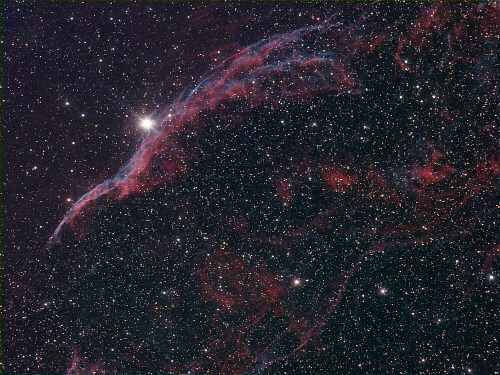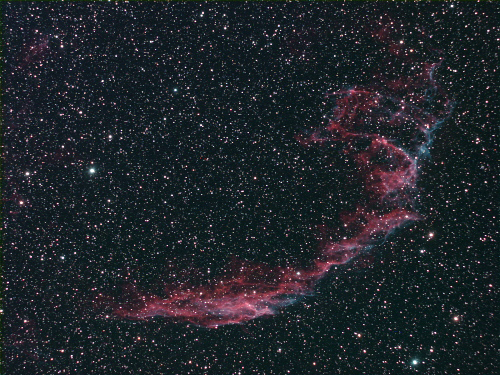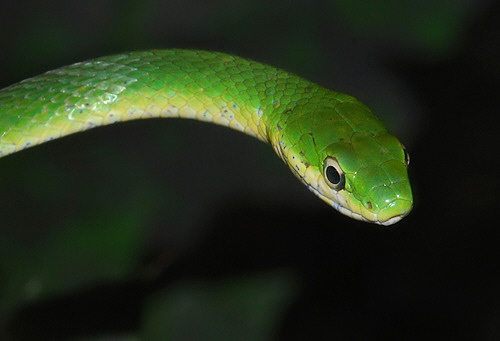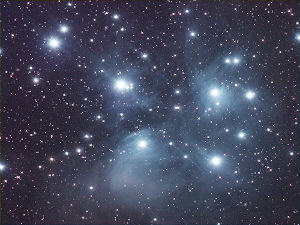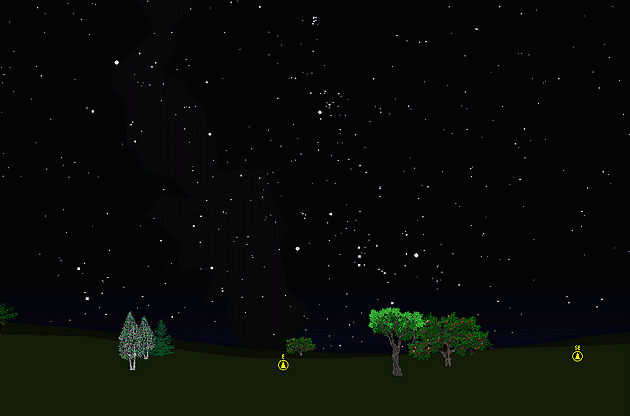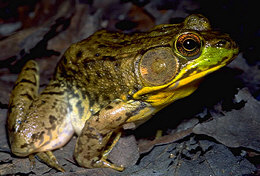The purpose of this feature is to give scout leaders, educators and naturalists an idea of some of the natural events coming up each month. We will try to cover a variety of natural events ranging from sky events to calling periods of amphibians, bird and mammal watching tips, prominent wildflowers and anything else that comes to mind. We will also note prominent constellations appearing over the eastern horizon at mid-evening each month for our area for those who would like to learn the constellations. If you have suggestions for other types of natural information you would like to see added to this calendar, let us know! Note: You can click on the hyperlinks to learn more about some of the featured items. To return to the Calendar, hit the "back" button on your browser, NOT the "back" button on the web page. All charts are available in a "printer friendly" mode, with black stars on a white background. Left clicking on each chart will take you to a printable black and white image.
Notes and Images From October 2008 I associate the constellation of Cygnus with the sights and sounds of a summer evening. But in October the Swan is still overhead at dusk. As the first strong cold fronts sweep out some of the summer haze, fall is a fine time to explore this constellation. Along the leading edge of one of the Swan's wings is a supernova remnant called the Veil Nebula. There is little in the lacy filaments of the Veil Nebula to suggest its violent origin. Somewhere between 5,000 and 15,000 years ago a star in Cygnus, a supergiant, reached the end of its life. The star's core collapsed and the star became a Type II supernova, exploding with incredible force. To observers on earth, the star would have rivaled the full moon in brightness and would have been visible in full daylight. Heavy elements like gold and silver are forged only in supernovas, and if you holding one of these elements in your hand you are holding a product of one of the most powerful explosions in the universe. A supernova can briefly outshine the combined light of all of the stars in the galaxy where it is located. As the shock wave races out from the exploding star it causes the surrounding interstellar material to glow. The Veil Nebula is a strong X-ray source, one of the brightest in the sky. To see an image at X-ray wavelengths made by the Rosat satellite, click here. The above images are in natural color. The red tints come from fluorescing hydrogen and the blue tints come from fluorescing oxygen. The bright star in the top image is 52 Cygni. It's a naked eye star and a convenient starting point for a search for the Veil. For finder charts, click the images above. You will see the negatives of the above images, which allow the full extent of the nebulosity to be better seen. The broken ring of glowing gas is about 3 degrees (6 full moons!) in diameter. From dark skies you can sometimes glimpse the eastern portion of the Veil (bottom image) in 10x50 binoculars. Unfortunately, the human eye does not respond well to color at low light levels, and the beautiful colors visible in the images are not visible in binoculars or small telescopes. The intertwining filaments of the nebula can be seen in larger amateur scopes, as well as a trace of color. We once had an unforgettable view of the Veil from Luna Lake in Arizona, using a 20" Newtonian reflector at 8,000 feet above sea level. In that beautiful setting the Milky Way was so bright it cast a shadow.
We came across this Rough Green Snake on October 18th along the border of our field. The scientific name, Opheodrys aestivus, translates to "summer tree snake" and these beautiful snakes are well camouflaged among the leaves. They like to climb and are often found in bushes and vines. They are quite harmless to humans, and prey on small insects, millipedes, spiders, land snails and treefrogs. Rough Green Snakes are found throughout the Southeast. In cold weather they seek shelter underground or in stumps or logs, where they go into a state of dormancy.
Sky Events for November 2008: The Southern Taurid meteor shower peaks on November 5th. The waxing crescent moon will set fairly early in the evening, producing good conditions for the morning hours. The Leonid Meteor Shower peaks during the morning hours of November 17th but a waning gibbous Moon will hamper observing. Evening Sky: Jupiter is in the southwestern sky at dusk. Venus rises higher into the southwestern sky as the month progresses, and the two planets appear to approach each other to within two degrees by the end of the month. Venus is much the brighter of the two. The two planets will be joined by a thin waxing crescent Moon on November 29th and 30th. Morning Sky: Saturn rises about 1:15am EST at midmonth in Leo. The rings are tilted so that they are almost edge-on to our line of sight, and you can get a good look at the planet if you wait till just before dawn. All times noted in the Sky Events are for Franklin, Tennessee and are Central Standard Time. These times should be pretty close anywhere in the mid-state area.
Constellations: The views below show the sky looking east at 9:30pm CST on November 8th. The first view shows the sky with the constellations outlined and names depicted. Star and planet names are in yellow. Constellation names are in green. The second view shows the same scene without labels. The Pleiades, a beautiful open star cluster, is now well up in the sky. The entire cluster is wreathed in faint nebulosity. Unlike the Veil Nebula, this nebula shines by reflected light. Dust illuminated by the stars in the cluster reflects predominantly blue light. Normally, the only part of the nebulosity visible in small telescopes is the purple-tinted area below Merope, and even then a very dark sky is required to see it. The Merope Nebula was discovered on October 19th, 1849 by Tempel, using a 4" refractor. He described it as appearing like "a breath on a mirror." In the above image, Merope is about three quarters of an inch above bottom center. Auriga, the Charioteer, with its bright star Capella, and Taurus, the Bull, with its bright star Aldebaran, are both prominent in the eastern sky. Look for the bright stars Castor and Pollux as the constellation Gemini, The Twins, clears the horizon. In the southeast, mighty Orion clears the horizon with its bright stars Betelgeuse and Rigel. Note the difference in color between the two stars. Betelgeuse is a red giant and looks orange. Rigel is very hot supergiant and looks bluish. Looking at the center of the three "sword" stars with binoculars, you can see M42, the Orion Nebula. Just poking its head above the horizon is Lepus, The Hare.
On Learning the Constellations: We advise learning a few constellations each month, and then following them through the seasons. Once you associate a particular constellation coming over the eastern horizon at a certain time of year, you may start thinking about it like an old friend, looking forward to its arrival each season. The stars in the evening scene above, for instance, will always be in the same place relative to the horizon at the same time and date each November. Of course, the planets do move slowly through the constellations, but with practice you will learn to identify them from their appearance. In particular, learn the brightest stars for they will guide you to the fainter stars. Once you can locate the more prominent constellations, you can "branch out" to other constellations around them. It may take you a little while to get a sense of scale, to translate what you see on the computer screen or what you see on the page of a book to what you see in the sky. Look for patterns, like the stars that make up Orion. The earth's rotation causes the constellations to
appear to move across the sky just as the sun and the moon appear to do.
If you go outside earlier than the time shown on the charts, the constellations
will be lower to the eastern horizon. If you observe later, they will
have climbed higher. As each season progresses, the earth's motion around the sun causes the constellations to appear a little farther towards the west each night for any given time of night. If you want to see where the constellations in the above figures will be on December 8th at 9:30pm CST, you can stay up till 11:30pm CST on November 8th and get a preview. The westward motion of the constellations is equivalent to two hours per month. Recommended: Sky Publishing has just come out with a beautiful and compact star atlas, Sky & Telescope's Pocket Star Atlas. It is destined to become a classic, and is a joy to use at the telescope. A good book to learn the constellations is Patterns in the Sky, by Hewitt-White. You may also want to check out at H. A. Rey's classic, The Stars, A New Way to See Them. For skywatching tips, an inexpensive good guide is Secrets of Stargazing, by Becky Ramotowski. A good general reference book on astronomy is the Peterson
Field Guide,
A Field Guide to the Stars and Planets, by Pasachoff. The book retails for around $14.00. Starry Night has several software programs for learning the night sky. Visit the Starry Night web site at www.starrynight.com for details.
Amphibians:
We think of November as the quietest time of year for Tennessee frogs and toads. However, some song can still occasionally be heard. Listen for Spring Peepers, Southeastern Chorus Frogs and Southern Leopard Frogs. Checking around ponds at night with a flashlight held next to your temple will many times show the eye shine of Southern Leopard Frogs, Green Frogs and Bullfrogs. As in October, you can locate many of the frogs and toads that have been calling more frequently earlier in the year by driving the back roads slowly on rainy nights. This is a two person job. One person watches the road for amphibians and one person looks out for other vehicles.
Birds: You probably have already put out your bird feeders, but if you haven't you'll be missing out on a lot of good looks at winter feeder birds. This is a great time of year to start learning bird identification. Watch and listen for fall arrivals like White-throated and White-crowned Sparrows, Yellow-bellied Sapsuckers, Red-breasted Nuthatches and Brown Creepers. Listen for Great Horned Owls dueting at dusk and dawn and sometimes through the night during their courtship period. Recommended: Bird Finding in Tennessee, Michael Lee Bierly. A classic guide to finding birds in Tennessee. The Sibley Guide to Birds, David Allen Sibley The Sibley Guide to Birds of Eastern North America, David Allen Sibley A Field Guide to the Birds of Eastern and Central North America, 5th edition. 2002. Roger Tory Peterson and Virginia Marie Peterson. If it's been a while since you've picked up a Peterson bird guide, you may be pleasantly surprised by the large image scale of the drawings. Just the thing for those fall warblers! An inexpensive guide for beginners is the Golden Guide for Birds.
Mammals: We find that fall is a good time to listen at dusk for Southern Flying Squirrels. If you have a nut-bearing tree or trees near you, they may be used by these interesting nocturnal mammals. Listen for very high-pitched, metallic squeaks coming from the canopy. To my ear they sound a little like the sound that steel rails make (the "singing") when a train is approaching. If you are very fortunate, you may be able to spot one. If you do, note the large eyes and the flattened tail, which they use like a rudder to steer their flight path. They fly, or rather glide, by extending a fold of skin that is attached to all four wrists. When they extend their legs outward, this flying membrane forms a flat surface beneath their body, allowing flight. They are very adept gliders. Although most glides are between 20 and 30 feet, one glide was measured covering 270 feet. Turns in the air of over 90 degrees are sometimes made. They are year-round residents.
Recommended: The Wild Mammals of Missouri, Charles W. Schwartz and Elizabeth R. Schwartz. University of Missouri Press. Although not written for Tennessee, most of the species covered in the book do occur in this state, and it is our favorite book on mammals. The book is beautifully illustrated with the drawings of Charles Schwartz and contains a wealth of information. If you buy only one book on mammals, we recommend this one.
Archives (Remember to use the back button on your browser, NOT the back button on the web page!) Natural Calendar September 2008 Natural Calendar February 2008 Natural Calendar December 2007 Natural Calendar November 2007 Natural Calendar September 2007 Natural Calendar February 2007 Natural Calendar December 2006 Natural Calendar November 2006 Natural Calendar September 2006 Natural Calendar February 2006
Natural Calendar
December 2005
Natural Calendar
November 2005
Natural Calendar
September 2005
Natural Calendar
February 2005
Natural Calendar
December 2004
Natural Calendar
November 2004
Natural Calendar
September 2004
Natural Calendar
February 2004
Natural Calendar
December 2003
Natural Calendar
November 2003
Natural Calendar
September 2003 Natural Calendar February 2003 Natural Calendar December 2002 Natural Calendar November 2002 Nature Notes Archives: Nature Notes was a page we published in 2001 and 2002 containing our observations about everything from the northern lights display of November 2001 to frog and salamander egg masses. Night scenes prepared with Starry Night Pro software All images and recordings © 2008 Leaps |
